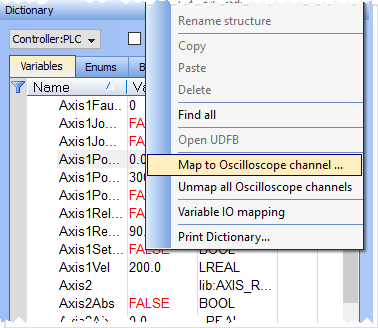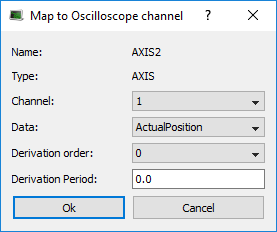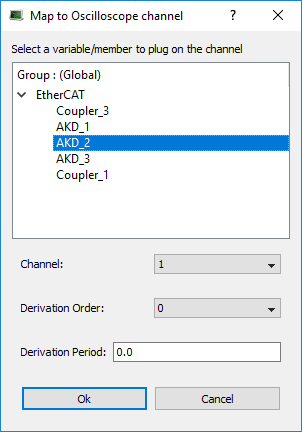Plugging a probe from the Dictionary
A probe (variable) can be directly plugged or mapped to the Oscilloscope from the Dictionary:
- In the Dictionary, right-click on the variable
- In the menu, select the Map to Oscilloscope channel … command

-
-
This command is enabled if the type of variable is eligible for the softscope (i.e. BOOL, INT, SINT, DINT, LINT, UINT, USINT, UDINT, ULINT, BYTE, WORD, DWORD, LWORD, TIME and LREAL, as long as they are not in a UDFB instance).
- Define the probe parameters.
There is a slight difference depending upon whether you selected a PipeNetwork probe, or a PLC "Programmable Logic Controller"
A Programmable Logic Controller, PLC, or Programmable Controller is a digital computer used for automation of industrial processes, such as control of machinery on factory assembly lines.
Used to synchronize the flow of inputs from (physical) sensors and events with the flow of outputs to actuators and events probe. With PipeNetwork variables you will need to select which Data point is being used, while PLC variables may require you to navigate within the group to find the correct item.
"Programmable Logic Controller"
A Programmable Logic Controller, PLC, or Programmable Controller is a digital computer used for automation of industrial processes, such as control of machinery on factory assembly lines.
Used to synchronize the flow of inputs from (physical) sensors and events with the flow of outputs to actuators and events probe. With PipeNetwork variables you will need to select which Data point is being used, while PLC variables may require you to navigate within the group to find the correct item. -
-
In order to enable the Plug on channel… dialog box, the KAS IDE
 "Integrated development environment"
An integrated development environment is a type of computer software that assists computer programmers in developing software.
IDEs normally consist of a source code editor, a compiler and/or interpreter, build-automation tools, and a debugger must be connected to the device first!
"Integrated development environment"
An integrated development environment is a type of computer software that assists computer programmers in developing software.
IDEs normally consist of a source code editor, a compiler and/or interpreter, build-automation tools, and a debugger must be connected to the device first!
Figure 6-33: Plugging a Probe from the Dictionary
Figure 6-34: Associating a PipeNetwork (left) and PLCopen (right) variable to a Channel
| Field | Description |
|---|---|
| Name | Variable's name |
| Type | Variable's type |
| Channel | Channel's number where the variable has to be plugged |
| Data | Desired variable information to show (the list depends on the type of Pipe Block. See sPipe Blocks Description for more details) |
| Derivation order | Performs a derivation of the measurement of the selected variable. If this value is different from 0, the derived value of the selected order is shown on the selected channel |
| Derivation Period | Specifies the modulo period for a periodic variable to remove spikes in the display of derivative orders greater than zero. The value entered should either be 0.0 (No Modulo) or the Modulo Period (eg. 360.0). |








